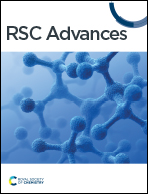A mesoporous Mo and N Co-doped TiO2 nanocomposite with enhanced photocatalytic efficiency
Abstract
This study reports the synthesis of a mesoporous Mo and N codoped anatase TiO2 nanocomposite with many oxygen vacancies using a simple one-step hydrothermal method and subsequent calcination treatment. Both Mo and N were effectively co-incorporated into the anatase phase of TiO2 without MoOx phase segregation. The codoped catalyst demonstrated a mesoporous architecture with a surface area of 107.48 m2 g−1 and a pore volume of 0.2974 cm3 g−1. X-ray photoelectron spectroscopy confirmed that both Mo and N dissolved in the TiO2 lattice and created induced oxygen vacancies. The interaction of the dopants (Mo and N) and oxygen vacancies clearly affected TiO2 crystal formation. Photocatalytic performance of the nanocomposite was investigated in terms of the decomposition of methyl orange at a concentration of 50 mg L−1 in an aqueous solution. The results revealed a significant methyl orange degradation of up to 99.6% after 30 min irradiation under a UV light. The impressive performance of the nanocomposite is assigned to the synergetic effect of important factors, including the co-doping of metallic (Mo) and non-metallic (N) elements, oxygen vacancy defects, bandgap, crystallite size, mesoporous structure, and BET surface area.



 Please wait while we load your content...
Please wait while we load your content...